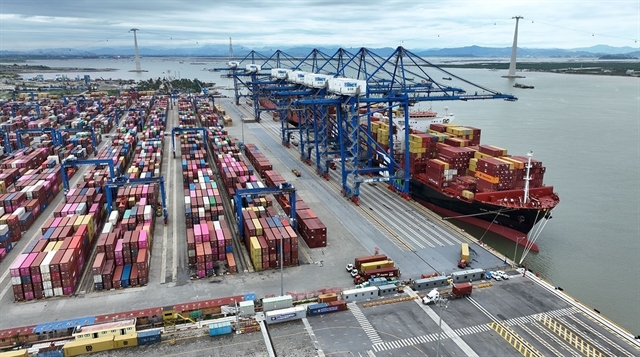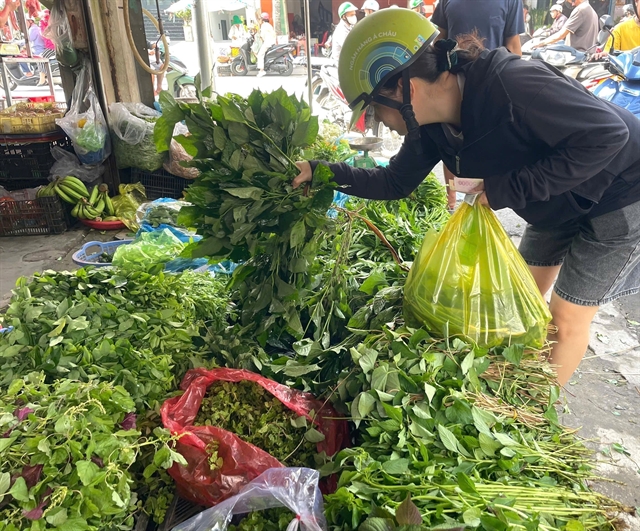 Features
Features
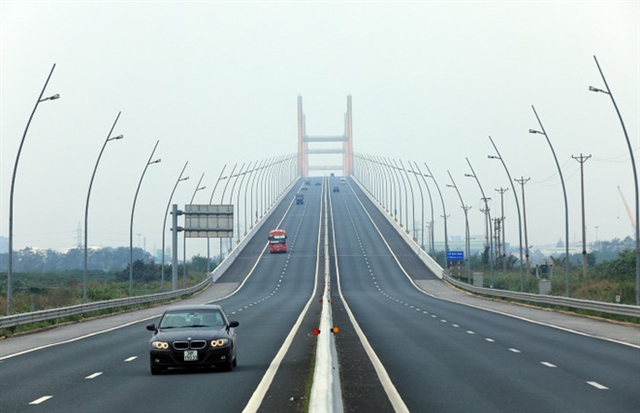
Under the influence of climate change and overexploitation, the amount of coral reefs worldwide, including in Phú Quốc District in the southern province of Kiên Giang, have reduced significantly. In an effort to preserve and revive nature’s precious gift, Phú Quốc Nature Reserve has been implementing a project of planting a coral reef nursery garden on the seabed. Nguyễn Triều spent a day with conservationists from the reserve.
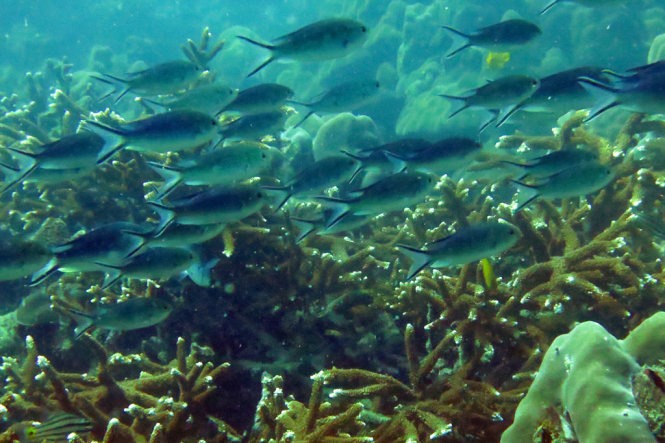 |
| Sea city: A developed coral reef is home to many kind of fish. Photo phuquocreal.vn |
Under the influence of climate change and overexploitation, the amount of coral reefs worldwide, including in Phú Quốc District in the southern province of Kiên Giang, have reduced significantly. In an effort to preserve and revive nature’s precious gift, Phú Quốc Nature Reserve has been implementing a project of planting a coral reef nursery garden on the seabed. Nguyễn Triều spent a day with conservationists from the reserve.
by Nguyễn Triều
When 11th lunar month comes, the high waves of the western sea in the southern province of Kiên Giang rise with each gust of north-easterly wind. From An Thới Harbour in Phú Quốc District, a wooden boat carries a group of conservationists from Phú Quốc Nature Reserve, heading south. A working day for the coral planters begins.
As soon as it approached the centre of Nhứt, a narrow channel that connects Phú Quốc Island and Dừa Islet, hundreds of miles off the coast, the boat encountered rows of waves each a metre in height. It bobbed up and down while the marking buoy, which can only be carried by two people, kept swinging aboard.
According to Nguyễn Linh Ngọc, the manager of the technology bureau from Phú Quốc Nature Reserve, the sailors’ trip loses its excitement if they don’t encounter waves on their trip to the open sea.
Garden on the seabed
After about 20 minutes, the boat reached Rỏi Islet and stopped amidst the waves, waiting for 56-year-old Nguyễn Văn Hải to row his boat and join the group. Hải has participated in the reserve’s coral reproduction project as a volunteer since its early days.
The boat continued to ride the waves heading for Đụng and Móng Tay Islets located in the heart of Phú Quốc Nature Reserve.
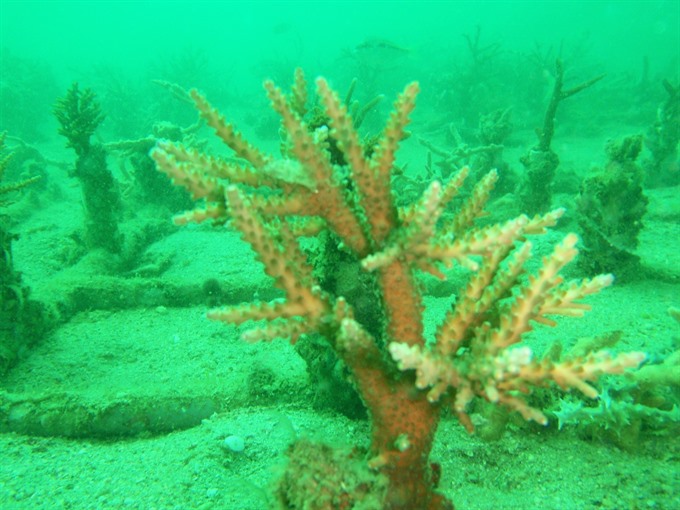 |
| Waterworld: A branch of staghorn coral develops well in Phú Quốc Nature Reserve. VNS Photo Nguyễn Triều |
It got more and more windy by noon. The boat struggled to maintain its balance amidst the strong gusts.
On approaching the sea area between the islets, a conservationist from the reserve whose first name is Tha, holding a GPS device in one hand while the other held tightly to the side of the boat, shouted commands to the pilot, ordering him to steer the boat to a better position before anchoring: “Move a little bit to the left! A little bit more! Drop the anchor!”
The groups of three conservationists, among whom Ngọc was the leader, hastily moved around the deck after donning their diving equipment and took turns jumping into the sea. About 7 metres under the hull is a coral nursery garden of roughly 40sq.m that they had planted just months ago. It is located between the two islets, meaning the current can be rapid. Today’s task was checking the survival capacity of each individual coral and replanting the dead ones.
On the seabed, each coral branch was fixed to supports; plastic frames anchored to the seafloor. Most of the branches were alive with good signs of development, with soft white buds beginning to show. All the workers raised their thumbs, indicating their satisfaction.
It took a long time to plant such a coral nursery garden on the seabed, Linh said. The frame to transplant the coral, which might be as wide as 3sq.m, is made with PVC pipes that are connected to each other. On top of the frames, a pipe of about 12cm high is attached, waiting for the growing coral branches.
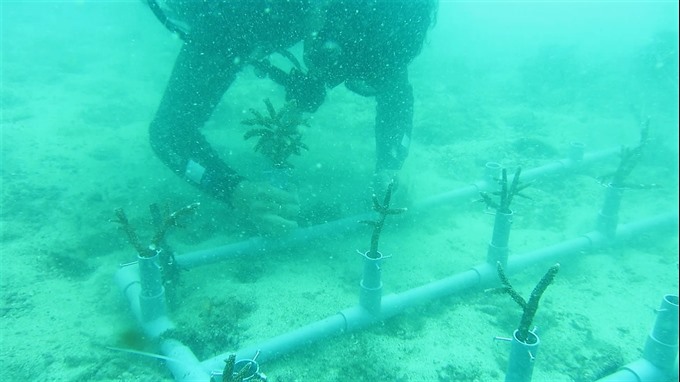 |
| Wet work: A technician from Phú Quốc Nature Reserve tends to the breed coral planted in the frame made from PVC pipes. VNS Photo Nguyễn Triều |
“Coral itself is sensitive to the surrounding environment so the location of the nursery garden has to satisfy very strict conditions, for example, the water source must not be polluted, and the location must not be too deep or too shallow. Most importantly, it has to be able to escape human influence,” Ngọc explained.
According to him, the selection of seed coral for genetic engineering also has to follow certain regulations. At present, Phú Quốc Nature Reserve only multiplies staghorn coral. The seed coral must show good development and consist of many branches.
When a seed coral has been selected, the technician will cut breed branches. They will then be preserved in sea water tanks that are provided with oxygen and moved to the awaiting locations. There the technicians will transplant each breed branch to available pipes and stabilise them with screws. The coral branches can then embark on their independent lives.
“The difficulty of nurturing coral is that its growth completely depends on itself and the surrounding natural environment. Humans cannot support its growth through fertilisation or spraying chemicals. Many coral individuals, which cannot be adaptive, willl not survive,” Ngọc said.
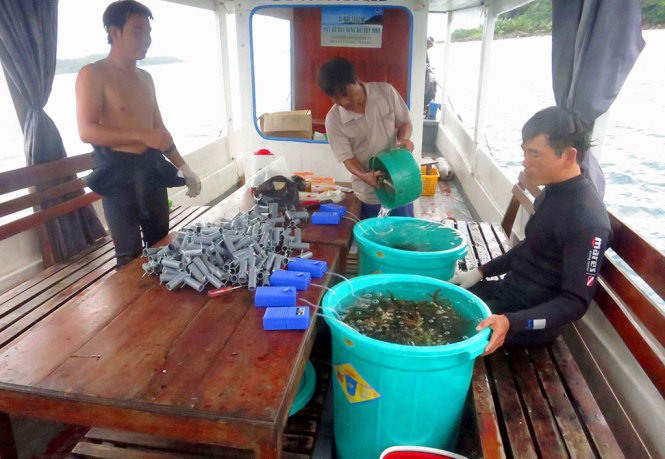 |
| Delicate work: On moving to the new coral reef, the breed coral branches are preserved in sea water tanks that are provided with oxygen constantly. Photo phuquocreal.vn |
Destroy in seconds, replant in years
According to Ngọc, the survival of the breed coral can be determined after two or three weeks. If they cannot continue, the branches will change colour and die.
However, it takes a long time for the surviving coral branches to continue growing and regenerate into new coral reef. Normally, it takes about two years to breed coral in the nursery garden in Phú Quốc, during which the technicians have to partake in dives regularly to keep a constant check.
After two years, the healthy breed coral will be separated from the garden to be planted permanently in the destroyed reef. It takes at least another three years for it to officially become a new “citizen” in the sea.
Surveys have shown that the total reef area in Phú Quốc District is about 500 ha, consisting of over 250 kinds of coral that are divided into 49 species. However, recent research also demonstrated that the population of coral in certain areas within the district has declined significantly.
In terms of natural influences, climate change over recent years, demonstrated by prolonged hot sunny days, has increased the temperature of the water near the islands, leading to death of coral. Meanwhile, human overexploitation for tourism purposes, like diving to see the coral has also left a profound impact, as the tourist boats anchor right above the reef area, and many tourists illegally pick the coral branches to take home as souvenirs.
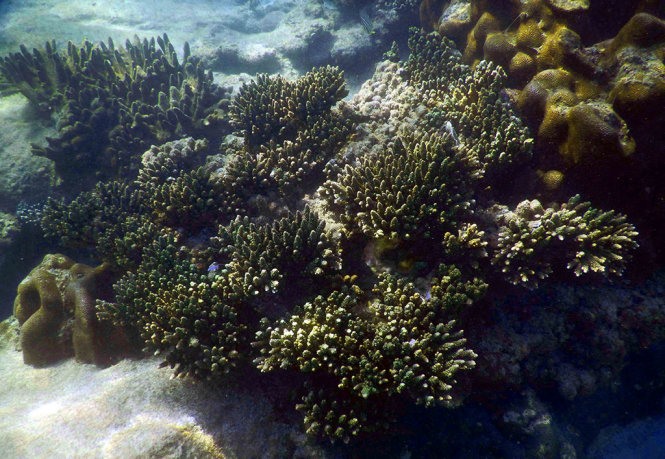 |
| Underwater bloom: A coral reef after being moved out of the coral nursery garden in Phú Quốc Nature Reserve flourishes in its new home. Photo phuquocreal.vn |
However, the biggest factor affecting the coral is the activity of seafood exploitation conducted by local fishermen. It is estimated that there are over 150 kinds of fish residing in the coral reefs of Phú Quốc, many of which have high economic value, like grouper or red snapper, as well as many kinds of invertebrate animals and echinoderms.
Hải, who used to be a diving fisherman in the district, said: “Groupers tend to live in the coral reef. The divers carry nets along with them. As soon as they discover the fish, they will run around as fast as possible while casting their nets to catch the fish, and trample on the rocks and even the reefs.”
He admitted that he used to treat the coral like that.
“I just cared about earning a living at that time. I was unaware that if there was no coral, the fish would leave, and there would be no fish left for our descendants. I felt a deep sense of regret,” he said.
That might explain why he has quit fishing and followed his new passion: supporting the project of replanting coral as a contributor in Phú Quốc District in recent years.
According to Hải, what makes matters worse is the use of chemicals by diving fishermen. Such chemicals will be sprayed into the coral holes and reefs to temporarily paralyse the fish to ease their capture. As a kind of animal, coral is extremely sensitive to chemicals, so this form of fishing is highly dangerous.
“The cost of planting one square metre of coral reef is about VNĐ3 million (US$132) and it takes five years. Once the coral reefs have been destroyed, not only does it take great efforts to revive them, but it also causes huge damage to the eco-system and the source of seafood. It is a tremendous price to pay,” Ngọc said. VNS
-

